Leadership in a Diverse Workplace: Challenges and Coca-Cola Example
VerifiedAdded on 2022/10/11
|13
|1145
|13
Presentation
AI Summary
This presentation focuses on the challenges leaders face in managing a diverse workforce in the business environment. It highlights issues arising from differing employee behaviors and opinions, leading to workplace conflicts. The presentation analyzes the Coca-Cola Company as a successful example of implementing diversity management practices, including parental benefits, the Millennial Voices group, and an open-door policy. It identifies crucial leadership skills such as interpersonal skills, positivity, delegating, and personal leadership. The presentation emphasizes the importance of effective leadership in maximizing diversity and provides key takeaways for leaders, including giving attention to subordinates, leading by listening, and spreading responsibility. The conclusion underscores the significance of leadership in implementing diversity management practices, acknowledging both the benefits and challenges diversity presents to a business.
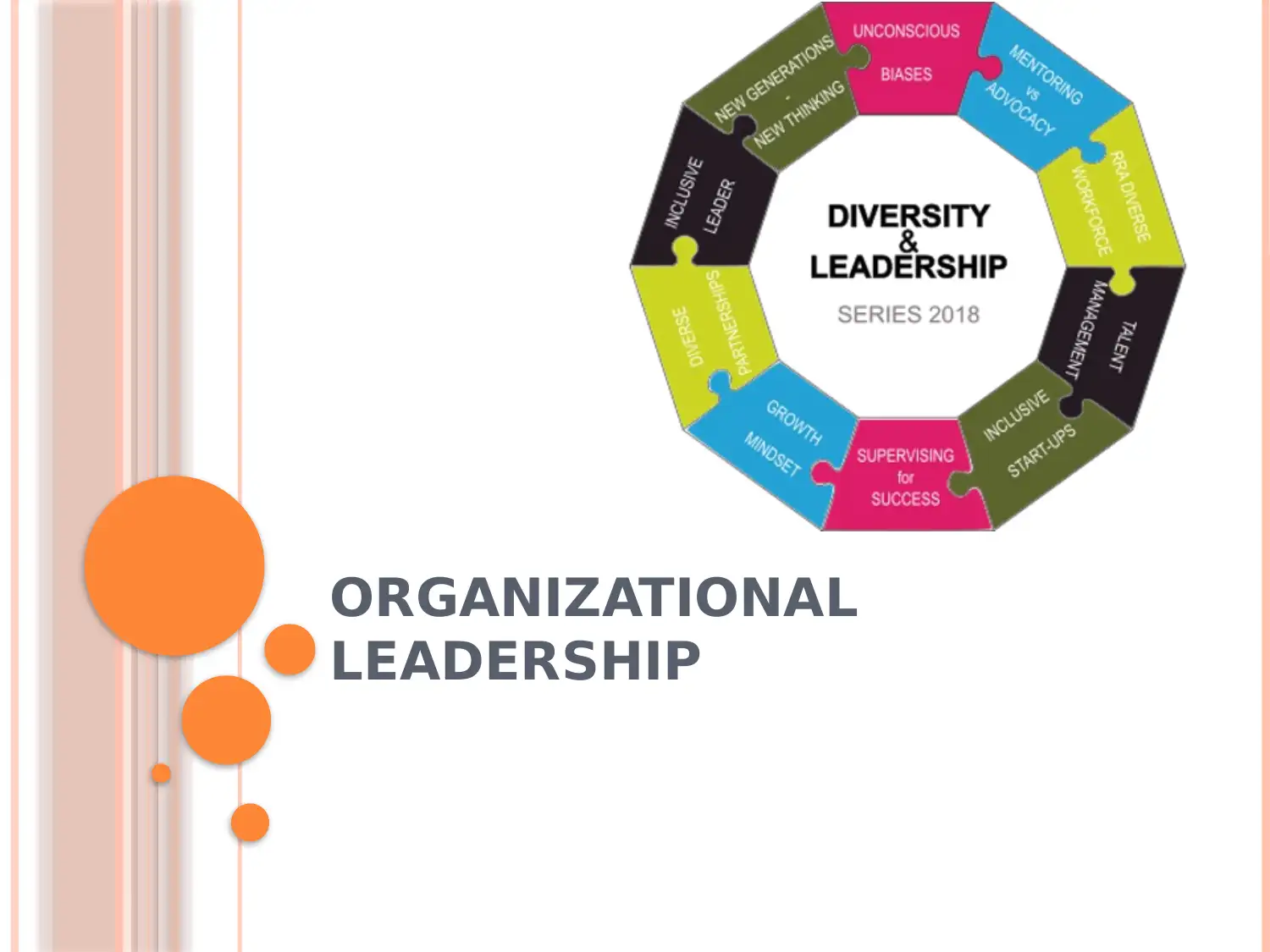
ORGANIZATIONAL
LEADERSHIP
LEADERSHIP
Paraphrase This Document
Need a fresh take? Get an instant paraphrase of this document with our AI Paraphraser
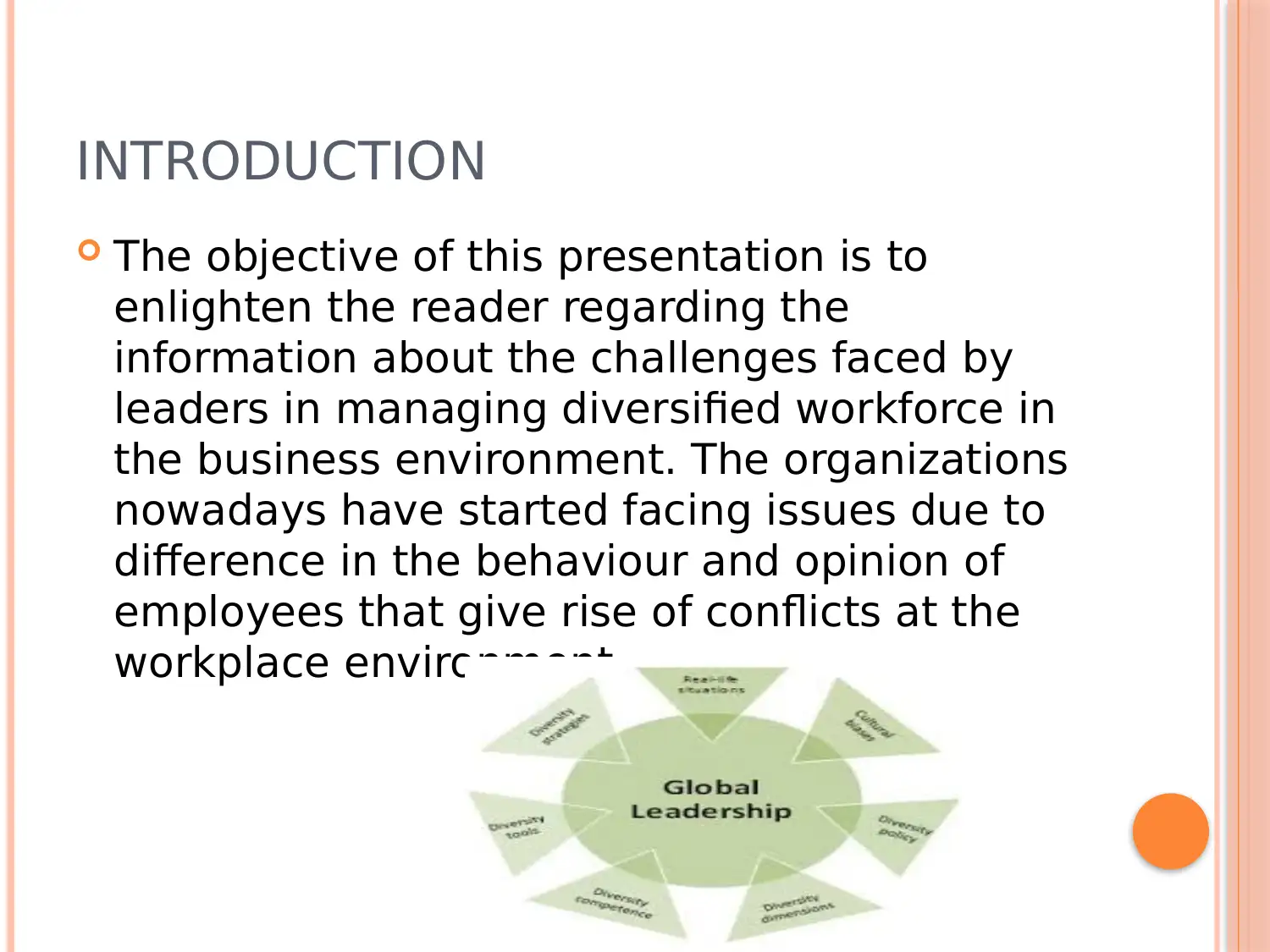
INTRODUCTION
The objective of this presentation is to
enlighten the reader regarding the
information about the challenges faced by
leaders in managing diversified workforce in
the business environment. The organizations
nowadays have started facing issues due to
difference in the behaviour and opinion of
employees that give rise of conflicts at the
workplace environment.
The objective of this presentation is to
enlighten the reader regarding the
information about the challenges faced by
leaders in managing diversified workforce in
the business environment. The organizations
nowadays have started facing issues due to
difference in the behaviour and opinion of
employees that give rise of conflicts at the
workplace environment.
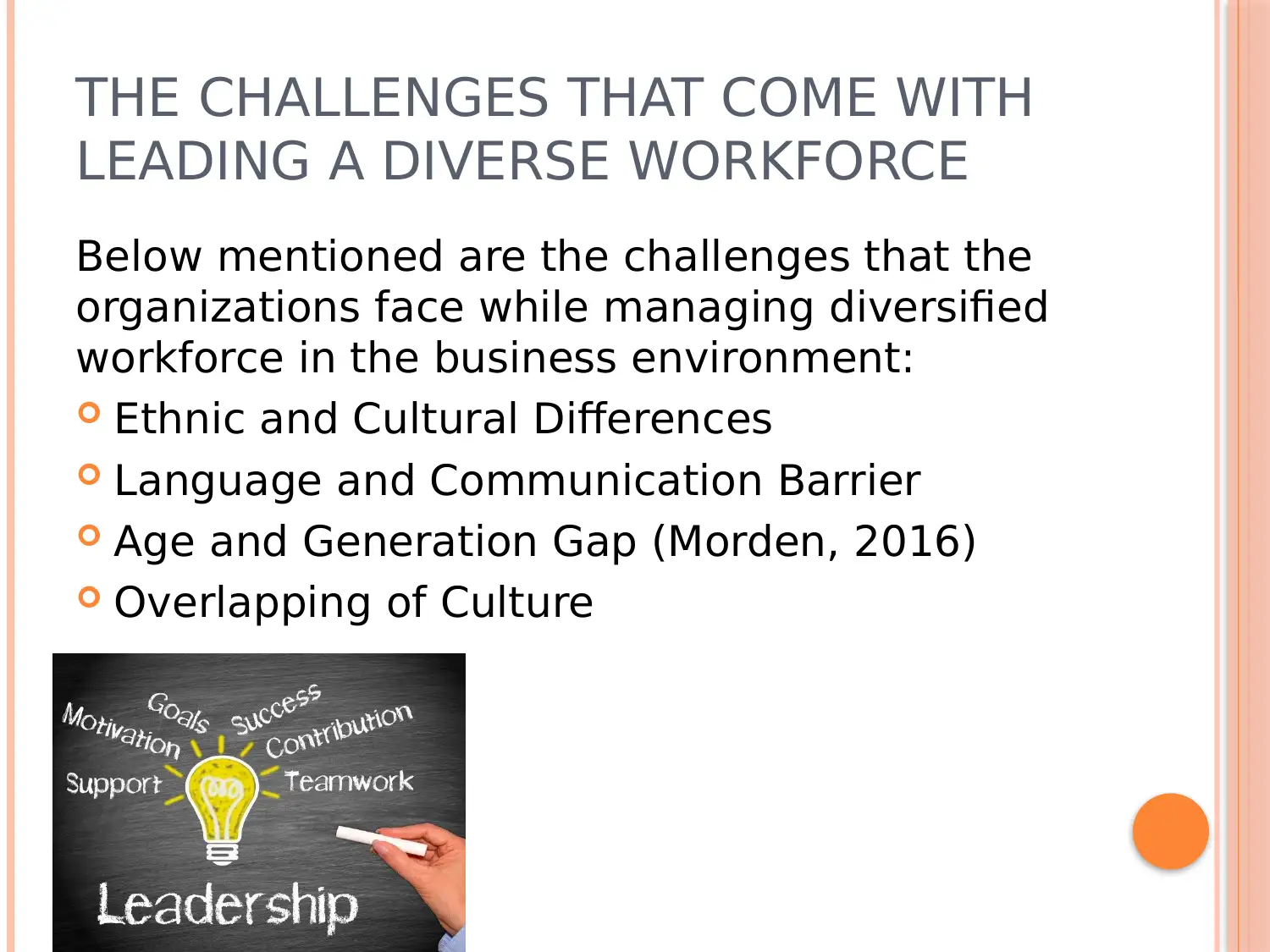
THE CHALLENGES THAT COME WITH
LEADING A DIVERSE WORKFORCE
Below mentioned are the challenges that the
organizations face while managing diversified
workforce in the business environment:
Ethnic and Cultural Differences
Language and Communication Barrier
Age and Generation Gap (Morden, 2016)
Overlapping of Culture
LEADING A DIVERSE WORKFORCE
Below mentioned are the challenges that the
organizations face while managing diversified
workforce in the business environment:
Ethnic and Cultural Differences
Language and Communication Barrier
Age and Generation Gap (Morden, 2016)
Overlapping of Culture
⊘ This is a preview!⊘
Do you want full access?
Subscribe today to unlock all pages.

Trusted by 1+ million students worldwide
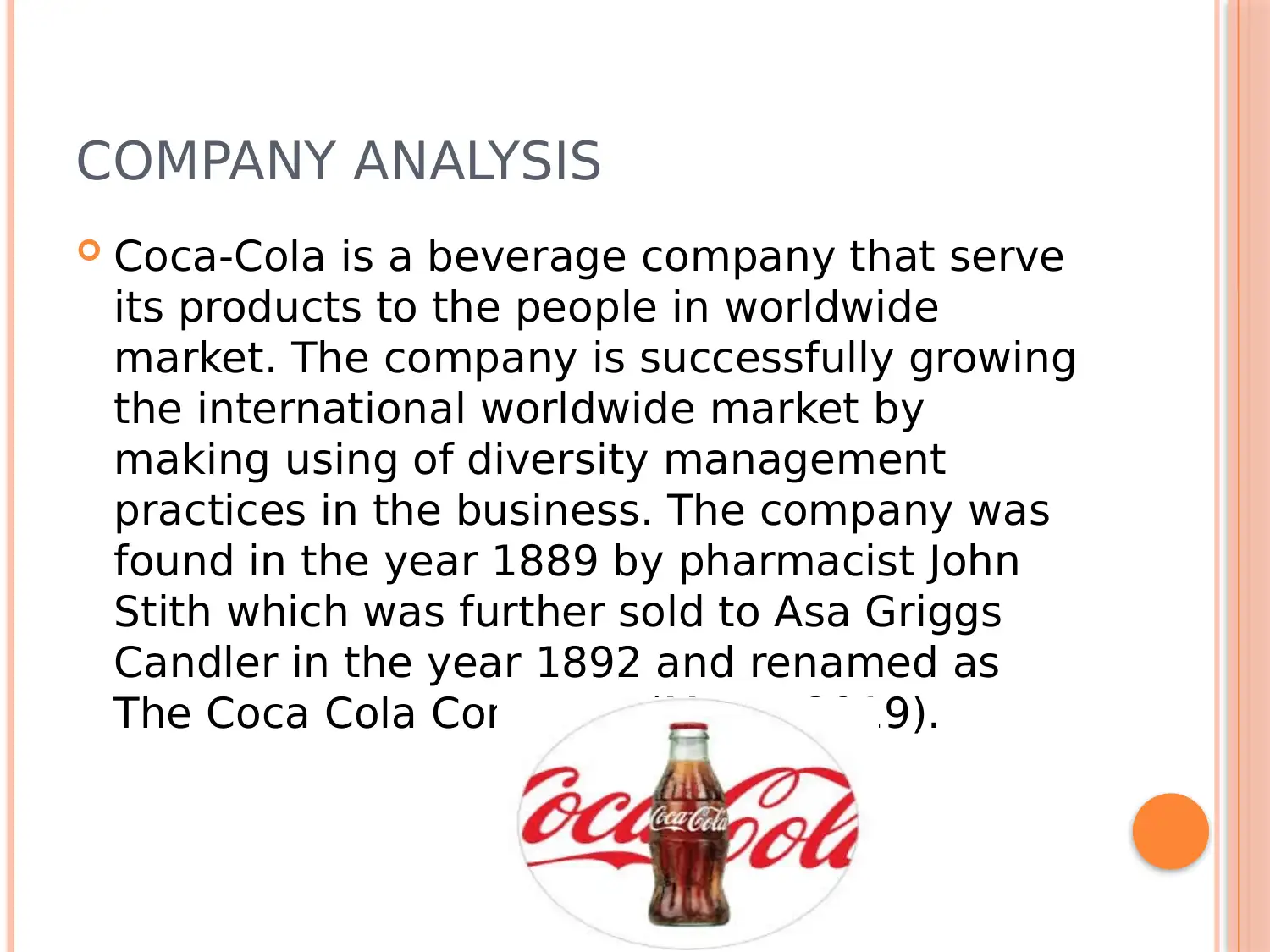
COMPANY ANALYSIS
Coca-Cola is a beverage company that serve
its products to the people in worldwide
market. The company is successfully growing
the international worldwide market by
making using of diversity management
practices in the business. The company was
found in the year 1889 by pharmacist John
Stith which was further sold to Asa Griggs
Candler in the year 1892 and renamed as
The Coca Cola Company (Moye, 2019).
Coca-Cola is a beverage company that serve
its products to the people in worldwide
market. The company is successfully growing
the international worldwide market by
making using of diversity management
practices in the business. The company was
found in the year 1889 by pharmacist John
Stith which was further sold to Asa Griggs
Candler in the year 1892 and renamed as
The Coca Cola Company (Moye, 2019).
Paraphrase This Document
Need a fresh take? Get an instant paraphrase of this document with our AI Paraphraser
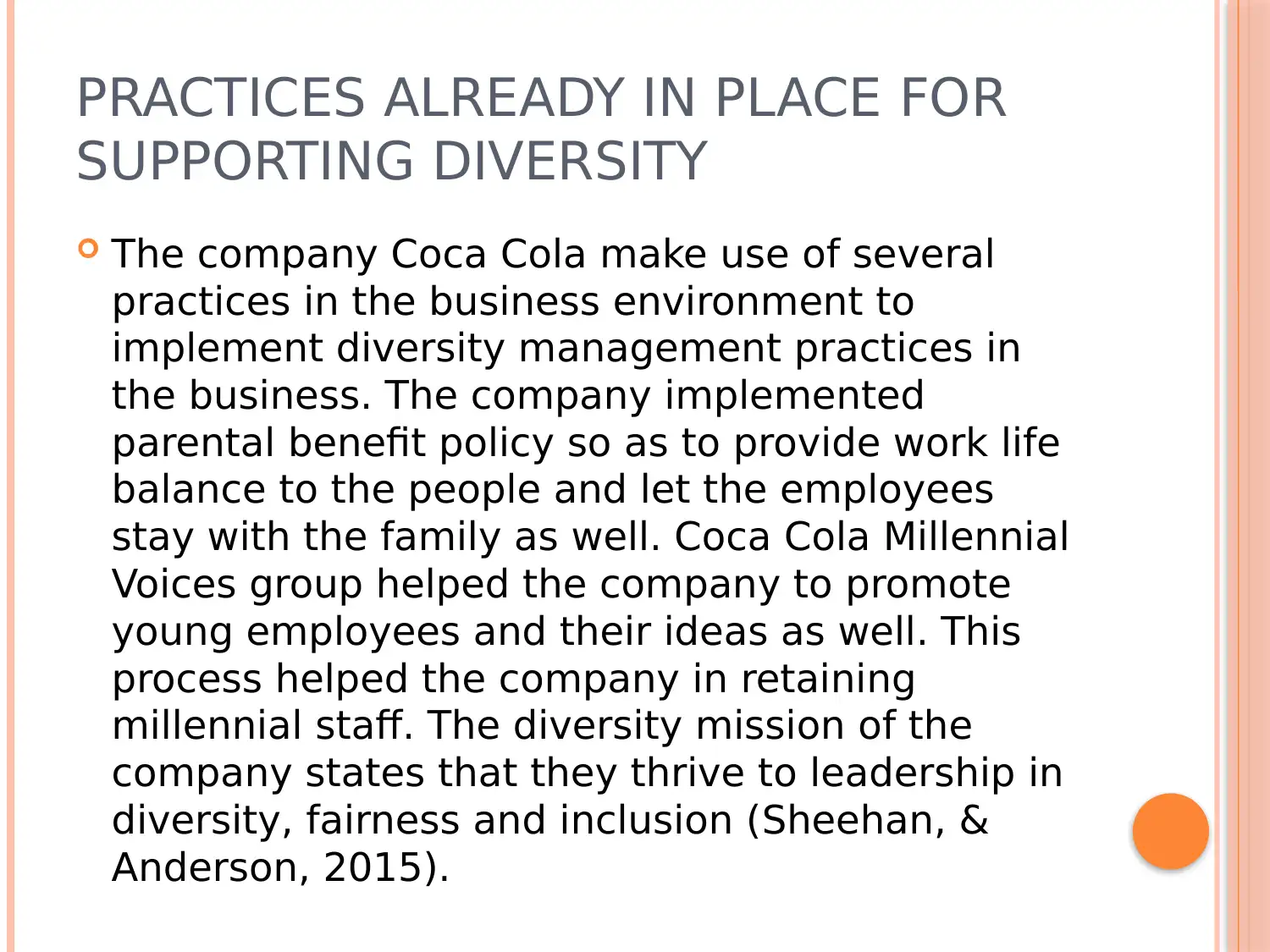
PRACTICES ALREADY IN PLACE FOR
SUPPORTING DIVERSITY
The company Coca Cola make use of several
practices in the business environment to
implement diversity management practices in
the business. The company implemented
parental benefit policy so as to provide work life
balance to the people and let the employees
stay with the family as well. Coca Cola Millennial
Voices group helped the company to promote
young employees and their ideas as well. This
process helped the company in retaining
millennial staff. The diversity mission of the
company states that they thrive to leadership in
diversity, fairness and inclusion (Sheehan, &
Anderson, 2015).
SUPPORTING DIVERSITY
The company Coca Cola make use of several
practices in the business environment to
implement diversity management practices in
the business. The company implemented
parental benefit policy so as to provide work life
balance to the people and let the employees
stay with the family as well. Coca Cola Millennial
Voices group helped the company to promote
young employees and their ideas as well. This
process helped the company in retaining
millennial staff. The diversity mission of the
company states that they thrive to leadership in
diversity, fairness and inclusion (Sheehan, &
Anderson, 2015).
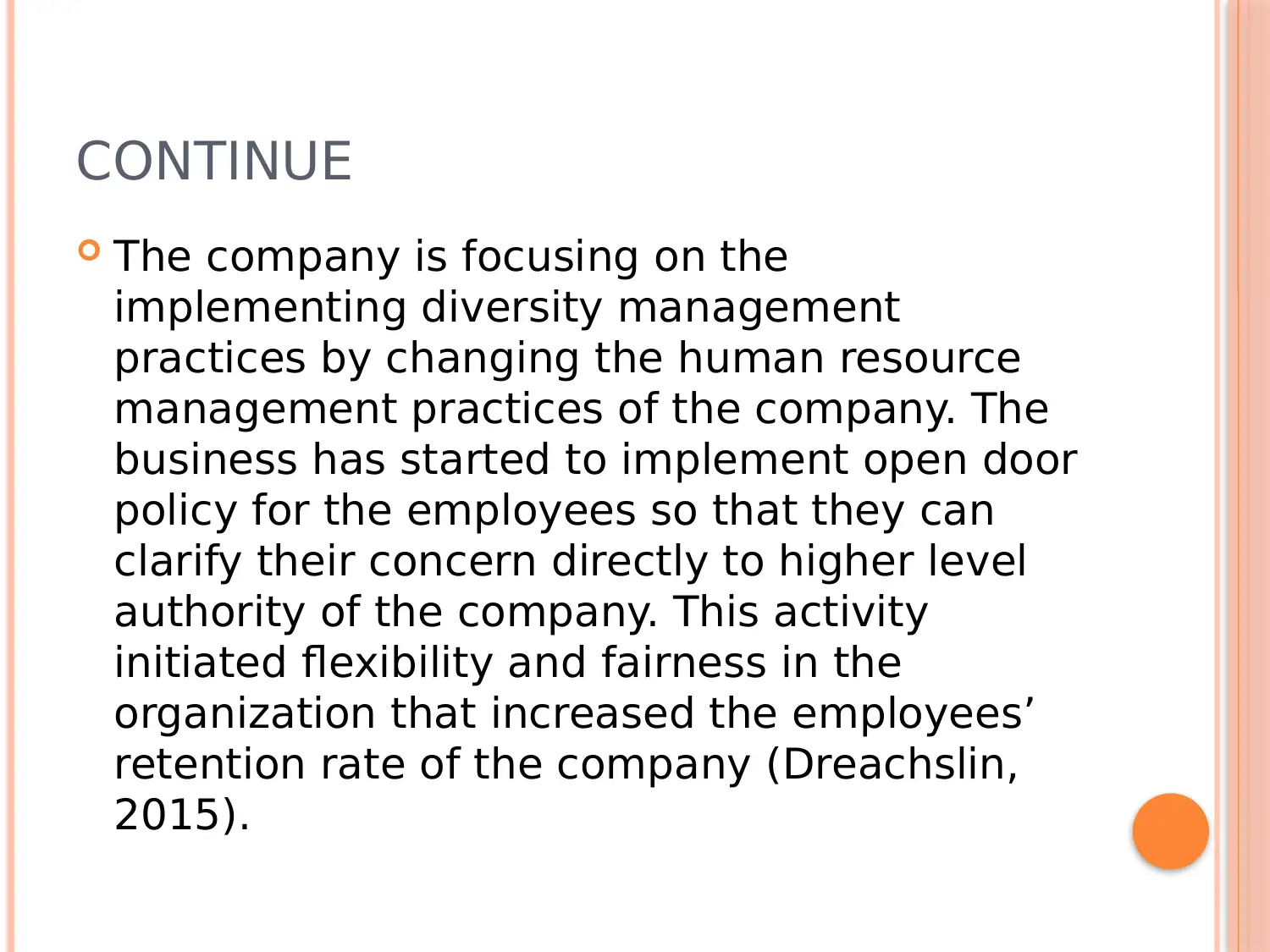
CONTINUE
The company is focusing on the
implementing diversity management
practices by changing the human resource
management practices of the company. The
business has started to implement open door
policy for the employees so that they can
clarify their concern directly to higher level
authority of the company. This activity
initiated flexibility and fairness in the
organization that increased the employees’
retention rate of the company (Dreachslin,
2015).
The company is focusing on the
implementing diversity management
practices by changing the human resource
management practices of the company. The
business has started to implement open door
policy for the employees so that they can
clarify their concern directly to higher level
authority of the company. This activity
initiated flexibility and fairness in the
organization that increased the employees’
retention rate of the company (Dreachslin,
2015).
⊘ This is a preview!⊘
Do you want full access?
Subscribe today to unlock all pages.

Trusted by 1+ million students worldwide
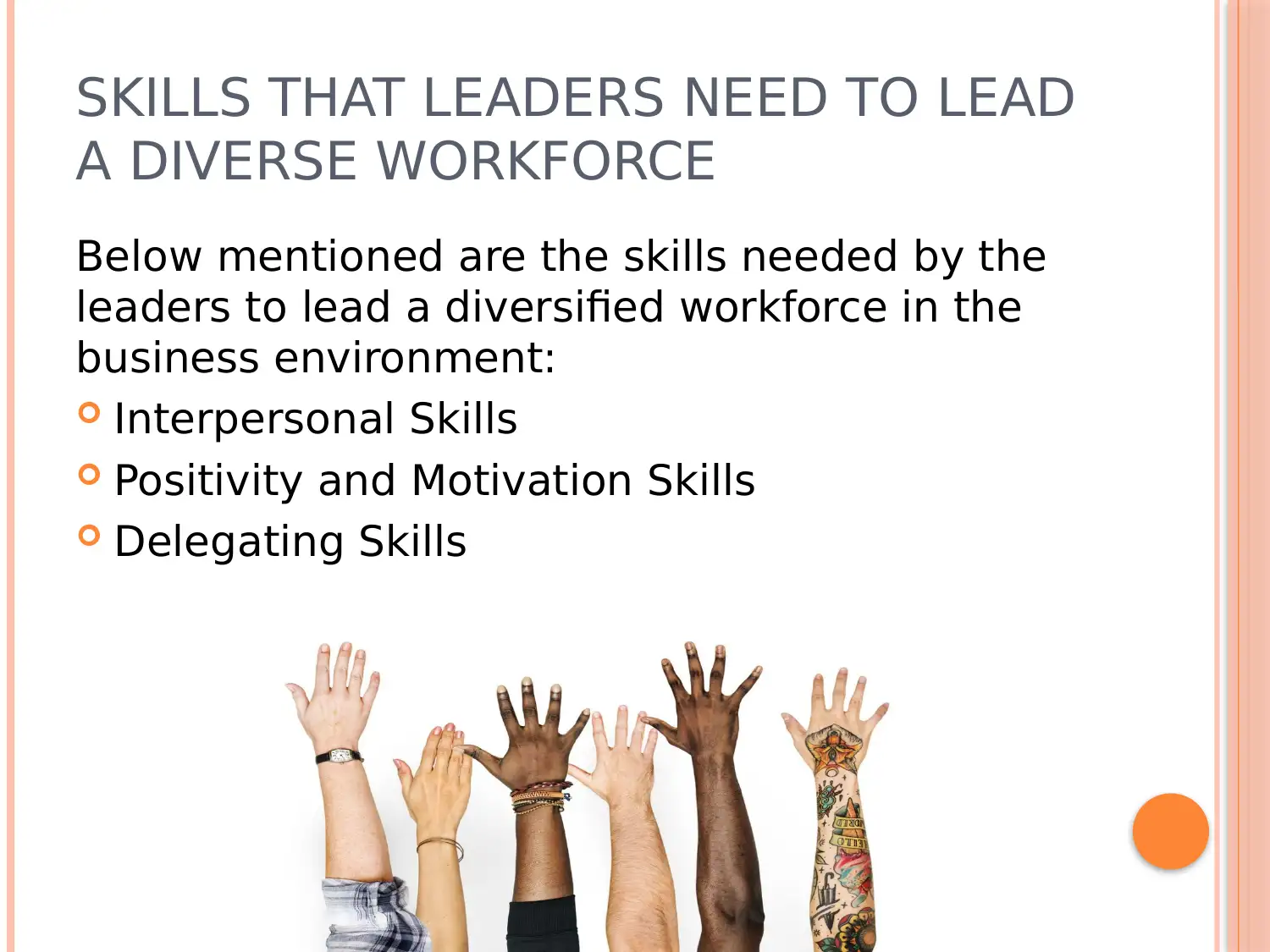
SKILLS THAT LEADERS NEED TO LEAD
A DIVERSE WORKFORCE
Below mentioned are the skills needed by the
leaders to lead a diversified workforce in the
business environment:
Interpersonal Skills
Positivity and Motivation Skills
Delegating Skills
A DIVERSE WORKFORCE
Below mentioned are the skills needed by the
leaders to lead a diversified workforce in the
business environment:
Interpersonal Skills
Positivity and Motivation Skills
Delegating Skills
Paraphrase This Document
Need a fresh take? Get an instant paraphrase of this document with our AI Paraphraser
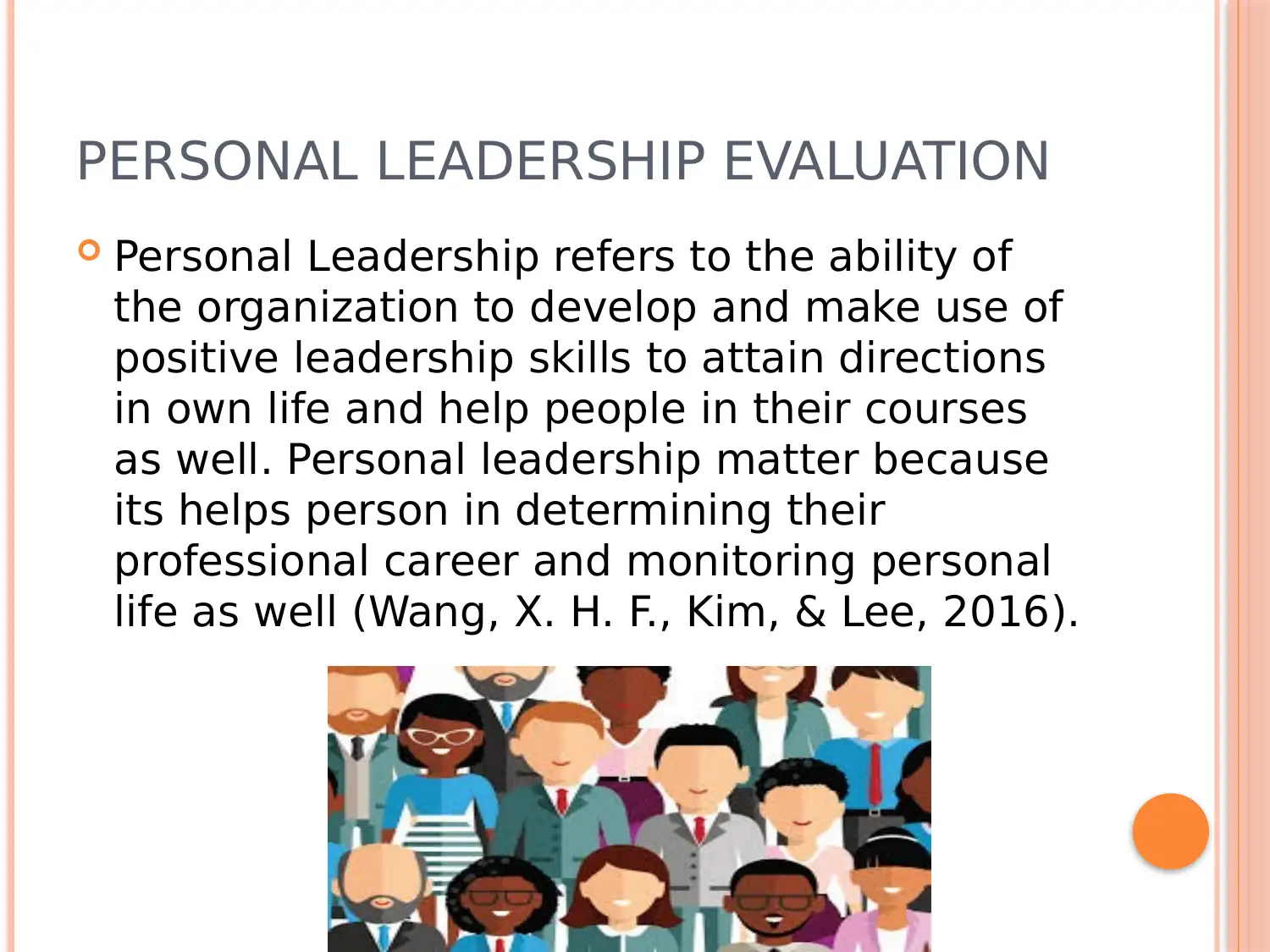
PERSONAL LEADERSHIP EVALUATION
Personal Leadership refers to the ability of
the organization to develop and make use of
positive leadership skills to attain directions
in own life and help people in their courses
as well. Personal leadership matter because
its helps person in determining their
professional career and monitoring personal
life as well (Wang, X. H. F., Kim, & Lee, 2016).
Personal Leadership refers to the ability of
the organization to develop and make use of
positive leadership skills to attain directions
in own life and help people in their courses
as well. Personal leadership matter because
its helps person in determining their
professional career and monitoring personal
life as well (Wang, X. H. F., Kim, & Lee, 2016).
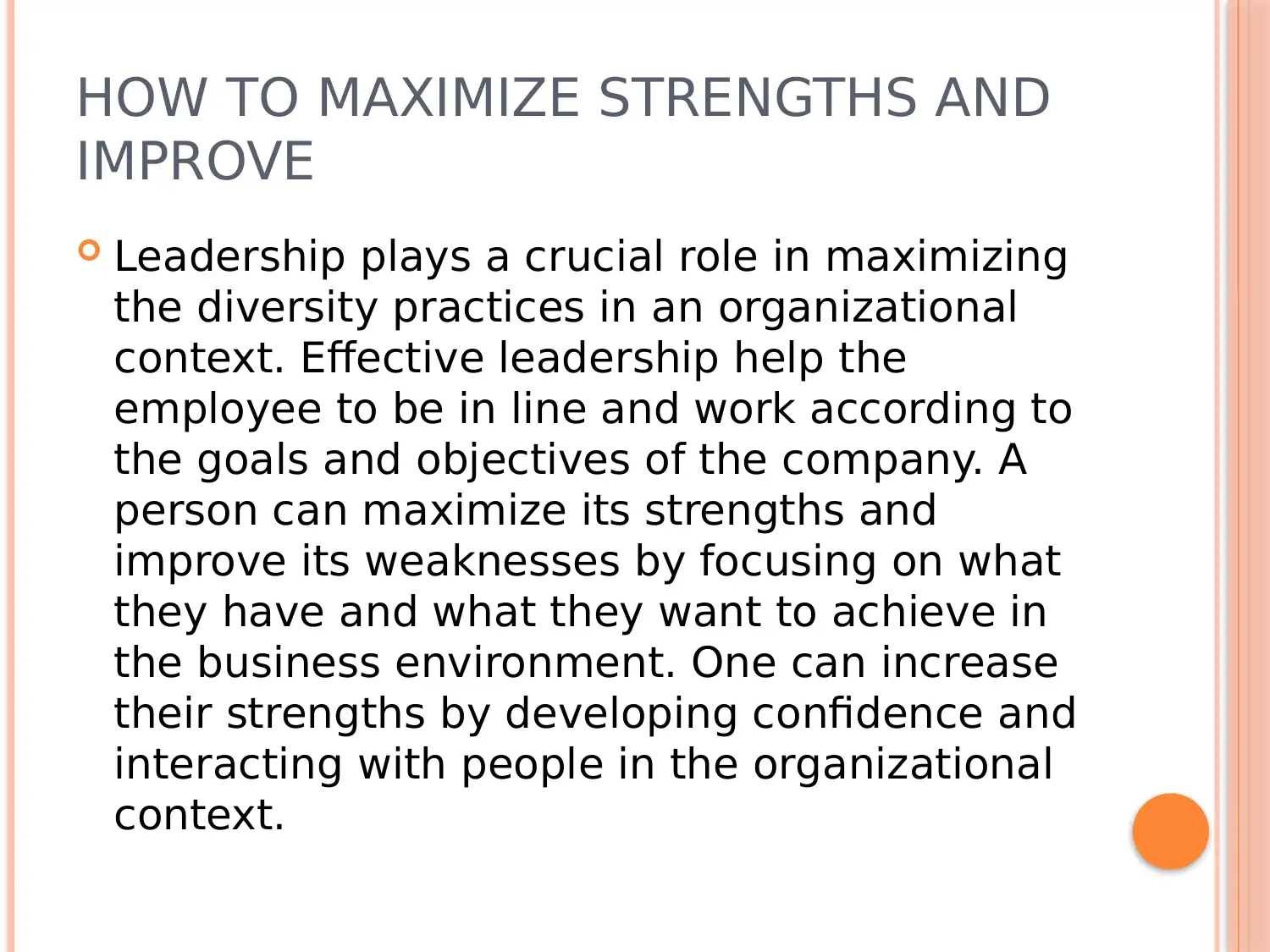
HOW TO MAXIMIZE STRENGTHS AND
IMPROVE
Leadership plays a crucial role in maximizing
the diversity practices in an organizational
context. Effective leadership help the
employee to be in line and work according to
the goals and objectives of the company. A
person can maximize its strengths and
improve its weaknesses by focusing on what
they have and what they want to achieve in
the business environment. One can increase
their strengths by developing confidence and
interacting with people in the organizational
context.
IMPROVE
Leadership plays a crucial role in maximizing
the diversity practices in an organizational
context. Effective leadership help the
employee to be in line and work according to
the goals and objectives of the company. A
person can maximize its strengths and
improve its weaknesses by focusing on what
they have and what they want to achieve in
the business environment. One can increase
their strengths by developing confidence and
interacting with people in the organizational
context.
⊘ This is a preview!⊘
Do you want full access?
Subscribe today to unlock all pages.

Trusted by 1+ million students worldwide
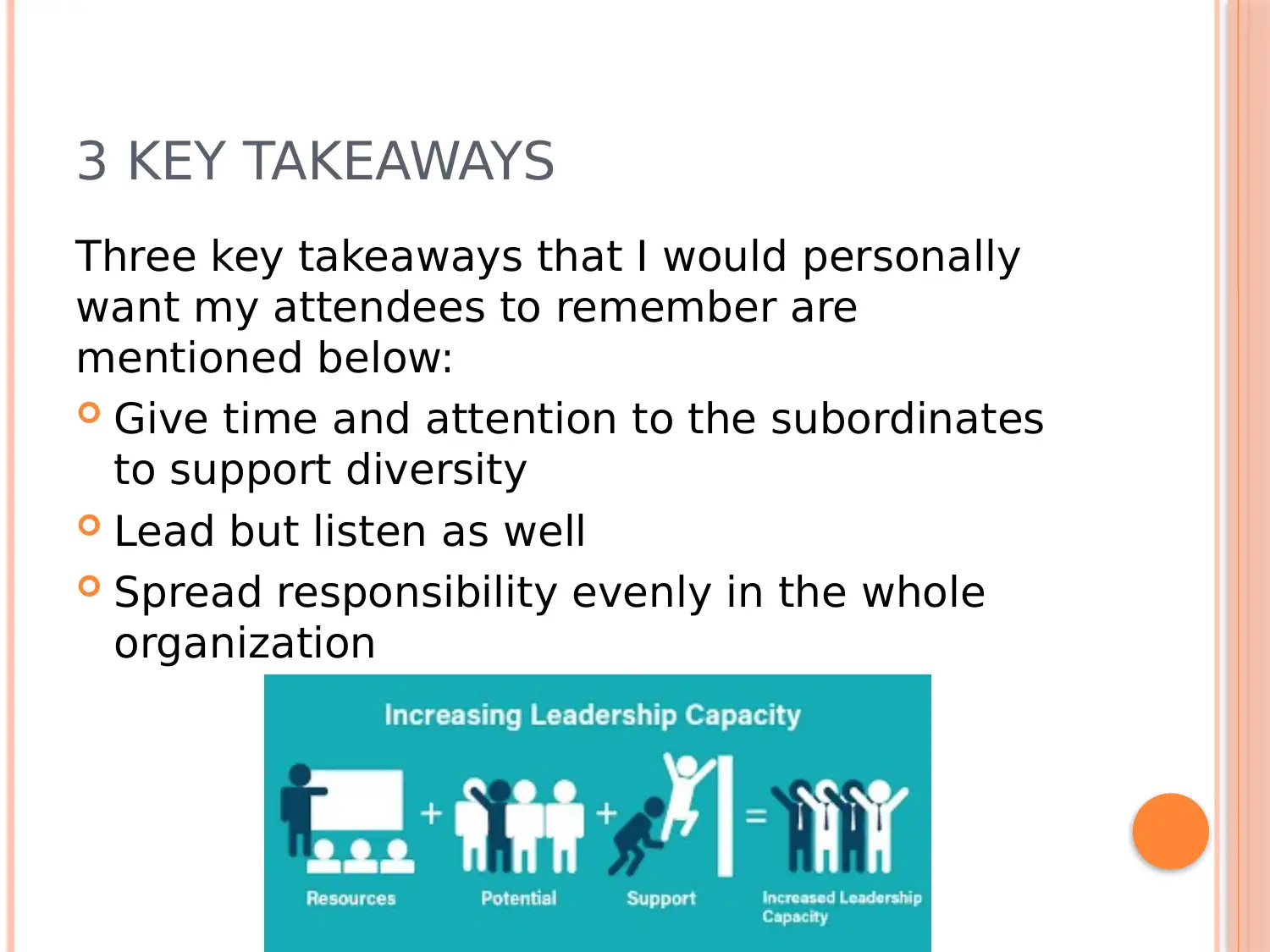
3 KEY TAKEAWAYS
Three key takeaways that I would personally
want my attendees to remember are
mentioned below:
Give time and attention to the subordinates
to support diversity
Lead but listen as well
Spread responsibility evenly in the whole
organization
Three key takeaways that I would personally
want my attendees to remember are
mentioned below:
Give time and attention to the subordinates
to support diversity
Lead but listen as well
Spread responsibility evenly in the whole
organization
Paraphrase This Document
Need a fresh take? Get an instant paraphrase of this document with our AI Paraphraser
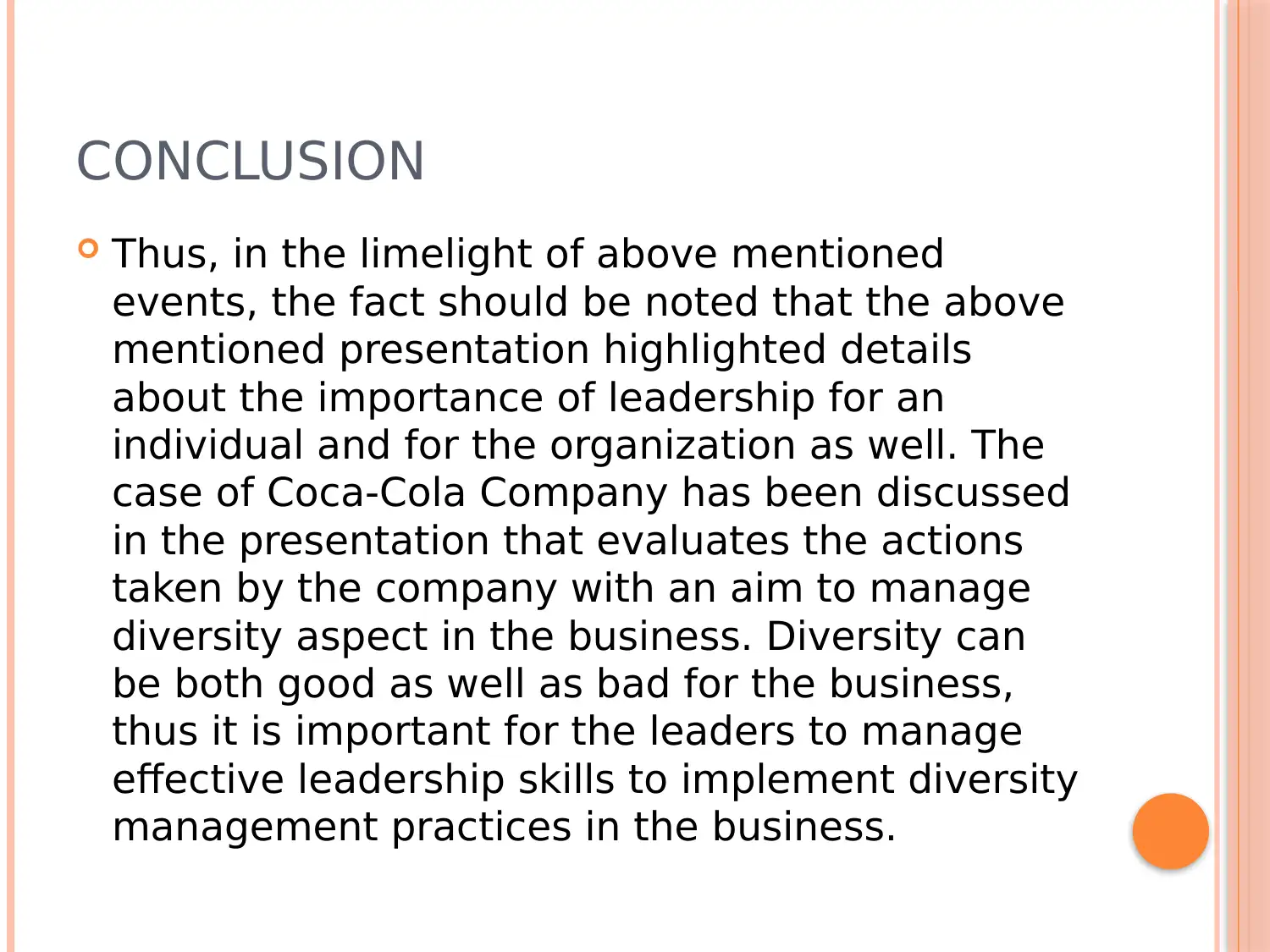
CONCLUSION
Thus, in the limelight of above mentioned
events, the fact should be noted that the above
mentioned presentation highlighted details
about the importance of leadership for an
individual and for the organization as well. The
case of Coca-Cola Company has been discussed
in the presentation that evaluates the actions
taken by the company with an aim to manage
diversity aspect in the business. Diversity can
be both good as well as bad for the business,
thus it is important for the leaders to manage
effective leadership skills to implement diversity
management practices in the business.
Thus, in the limelight of above mentioned
events, the fact should be noted that the above
mentioned presentation highlighted details
about the importance of leadership for an
individual and for the organization as well. The
case of Coca-Cola Company has been discussed
in the presentation that evaluates the actions
taken by the company with an aim to manage
diversity aspect in the business. Diversity can
be both good as well as bad for the business,
thus it is important for the leaders to manage
effective leadership skills to implement diversity
management practices in the business.
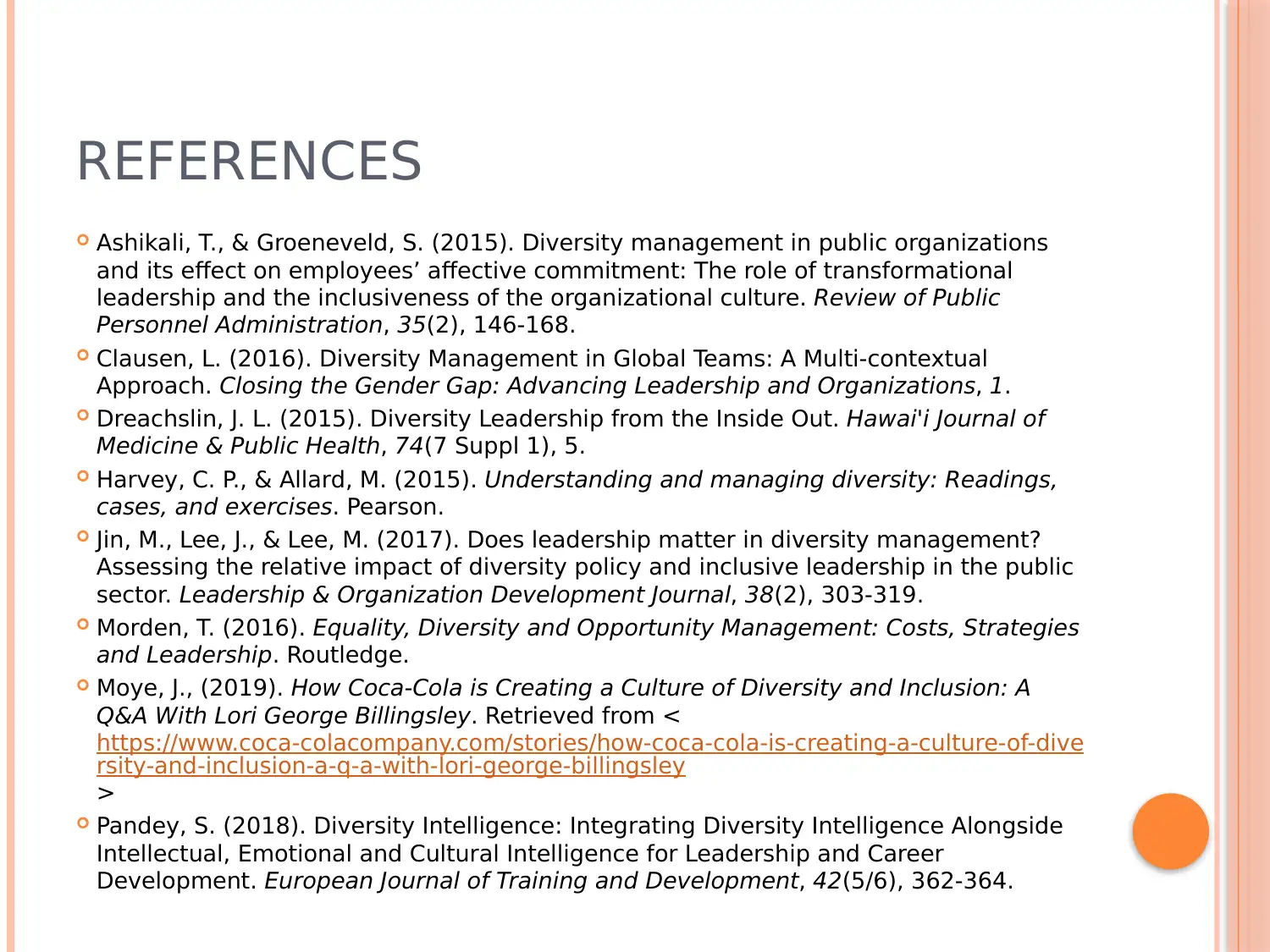
REFERENCES
Ashikali, T., & Groeneveld, S. (2015). Diversity management in public organizations
and its effect on employees’ affective commitment: The role of transformational
leadership and the inclusiveness of the organizational culture. Review of Public
Personnel Administration, 35(2), 146-168.
Clausen, L. (2016). Diversity Management in Global Teams: A Multi-contextual
Approach. Closing the Gender Gap: Advancing Leadership and Organizations, 1.
Dreachslin, J. L. (2015). Diversity Leadership from the Inside Out. Hawai'i Journal of
Medicine & Public Health, 74(7 Suppl 1), 5.
Harvey, C. P., & Allard, M. (2015). Understanding and managing diversity: Readings,
cases, and exercises. Pearson.
Jin, M., Lee, J., & Lee, M. (2017). Does leadership matter in diversity management?
Assessing the relative impact of diversity policy and inclusive leadership in the public
sector. Leadership & Organization Development Journal, 38(2), 303-319.
Morden, T. (2016). Equality, Diversity and Opportunity Management: Costs, Strategies
and Leadership. Routledge.
Moye, J., (2019). How Coca-Cola is Creating a Culture of Diversity and Inclusion: A
Q&A With Lori George Billingsley. Retrieved from <
https://www.coca-colacompany.com/stories/how-coca-cola-is-creating-a-culture-of-dive
rsity-and-inclusion-a-q-a-with-lori-george-billingsley
>
Pandey, S. (2018). Diversity Intelligence: Integrating Diversity Intelligence Alongside
Intellectual, Emotional and Cultural Intelligence for Leadership and Career
Development. European Journal of Training and Development, 42(5/6), 362-364.
Ashikali, T., & Groeneveld, S. (2015). Diversity management in public organizations
and its effect on employees’ affective commitment: The role of transformational
leadership and the inclusiveness of the organizational culture. Review of Public
Personnel Administration, 35(2), 146-168.
Clausen, L. (2016). Diversity Management in Global Teams: A Multi-contextual
Approach. Closing the Gender Gap: Advancing Leadership and Organizations, 1.
Dreachslin, J. L. (2015). Diversity Leadership from the Inside Out. Hawai'i Journal of
Medicine & Public Health, 74(7 Suppl 1), 5.
Harvey, C. P., & Allard, M. (2015). Understanding and managing diversity: Readings,
cases, and exercises. Pearson.
Jin, M., Lee, J., & Lee, M. (2017). Does leadership matter in diversity management?
Assessing the relative impact of diversity policy and inclusive leadership in the public
sector. Leadership & Organization Development Journal, 38(2), 303-319.
Morden, T. (2016). Equality, Diversity and Opportunity Management: Costs, Strategies
and Leadership. Routledge.
Moye, J., (2019). How Coca-Cola is Creating a Culture of Diversity and Inclusion: A
Q&A With Lori George Billingsley. Retrieved from <
https://www.coca-colacompany.com/stories/how-coca-cola-is-creating-a-culture-of-dive
rsity-and-inclusion-a-q-a-with-lori-george-billingsley
>
Pandey, S. (2018). Diversity Intelligence: Integrating Diversity Intelligence Alongside
Intellectual, Emotional and Cultural Intelligence for Leadership and Career
Development. European Journal of Training and Development, 42(5/6), 362-364.
⊘ This is a preview!⊘
Do you want full access?
Subscribe today to unlock all pages.

Trusted by 1+ million students worldwide
1 out of 13
Related Documents
Your All-in-One AI-Powered Toolkit for Academic Success.
+13062052269
info@desklib.com
Available 24*7 on WhatsApp / Email
![[object Object]](/_next/static/media/star-bottom.7253800d.svg)
Unlock your academic potential
Copyright © 2020–2025 A2Z Services. All Rights Reserved. Developed and managed by ZUCOL.





